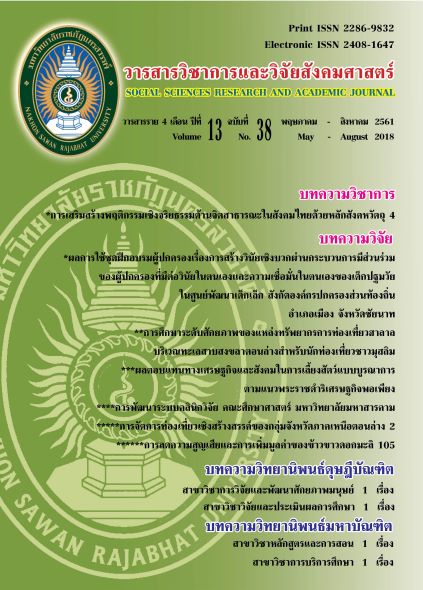การพัฒนาระบบการวินิจฉัยข้อบกพร่องทางการเรียนคณิตศาสตร์เรื่อง สมการ ของนักเรียนชั้นประถมศึกษาปีที่ 6 Development of the System on Defects Diagnostic the Study of Mathematics Equation for Sixth Grade Students
Main Article Content
Abstract
การวิจัยครั้งนี้มีวัตถุประสงค์เพื่อ 1) พัฒนาคลังข้อสอบวินิจฉัยข้อบกพร่องทางการเรียนคณิตศาสตร์เรื่องสมการโดยการสร้างแบบทดสอบแบบเลือกตอบ จำนวน 4 ตัวเลือก จำนวน 120 ข้อ นำข้อสอบไปให้ผู้เชี่ยวชาญตรวจสอบมีข้อสอบที่ผ่านคัดเลือกจำนวน 90 ข้อ นำไปทดสอบกับนักเรียนชั้นประถมศึกษาปีที่ 6 ในภาคตะวันออกเฉียงเหนือที่เป็นกลุ่มตัวอย่าง จำนวน 1,314 คน ได้มาโดยการสุ่มแบบหลายขั้นตอน นำผลการทดสอบมาวิเคราะห์หาคุณภาพของข้อสอบและคัดเลือกข้อสอบเข้าคลังข้อสอบ 2) พัฒนาโปรแกรมวินิจฉัยข้อบกพร่องทางการเรียนคณิตศาสตร์ เรื่องสมการ พร้อมคู่มือการใช้งานโปรแกรม โดยนำโปรแกรมการทดสอบเสนอผู้เชี่ยวชาญจำนวน 5 คนตรวจสอบและสัมภาษณ์การใช้งานโปรแกรม และ3)ประเมินผลโปรแกรมการวินิจฉัยข้อบกพร่องทางการเรียนคณิตศาสตร์ เรื่องสมการ ของนักเรียนชั้นประถมศึกษาปีที่ 6 โดยการนำโปรแกรมไปทดสอบกับนักเรียนที่มีผลสัมฤทธิ์ทางการเรียนคณิตศาสตร์สูงและนักเรียนที่มีผลสัมฤทธิ์ทางการเรียนต่ำ จำนวนกลุ่มละ 5 คน และวิเคราะห์ข้อมูลโดยใช้สถิติ Mann-Whitney U– test ผลการวิจัยและพัฒนา พบว่า1) คลังข้อสอบเรื่องสมการ ของนักเรียนชั้นประถมศึกษาปีที่ 6 ประกอบด้วยข้อสอบจำนวนทั้งสิ้น 75 ข้อมีค่าความยากระหว่าง 0.23 - 0.75 และค่าอำนาจจำแนกระหว่าง 0.28 – 0.68 โดยเก็บไว้ในฐานข้อมูลออนไลน์ 2) ผลการพัฒนาโปรแกรมวินิจฉัยข้อบกพร่องทางการเรียนคณิตศาสตร์เรื่องสมการของนักเรียนชั้นประถมศึกษาปีที่ 6 ปรากฏผลดังนี้ โปรแกรมสามารถใช้งานได้กับระบบปฏิบัติการ Windows 7 ขึ้นไปและสามารถทำการทดสอบแบบออนไลน์ได้ นักเรียนสามารถทำการทดสอบด้วยตนเอง และทราบผลการทดสอบได้ทันที และ3) ผลการประเมินโปรแกรมวินิจฉัยข้อบกพร่องทางการเรียนคณิตศาสตร์ เรื่องสมการของนักเรียนชั้นประถมศึกษาปีที่ 6 พบว่านักเรียนที่มีผลสัมฤทธิ์ทางการเรียนคณิตศาสตร์สูงมีคะแนนเฉลี่ยสูงกว่านักเรียนที่มีผลสัมฤทธิ์ทางการเรียนคณิตศาสตร์ต่ำอย่างมีนัยสำคัญทางสถิติที่ระดับ .05 แสดงว่าโปรแกรมสามารถจำแนกนักเรียนที่มีความบกพร่องทางการเรียนเรื่องสมการได้ตรงตามสภาพความเป็นจริง
The development of mathematical defects diagnostic the study of equation of the sixth grade students was the study with the aims to 1) develop diagnostics test bank in mathematics for defects in study of equation. The researcher created a multiple choices quiz of 120 questions with four options, each option identified above mentioned defects. The experts considered consistency of the test with defects to learn equation among the sixth grade students, through the selection of 90 questions. The test was administered to the sixth grade students in the Northeast. The sample of 1,314 people, which were acquired by a multi-stage random sampling method. Test result determined the quality of the tests and examination criteria to recruit items into the test bank, 2) development of program for defects diagnostics the study of mathematics equation. The program was incorporated with manual of operation. Test program by connoisseur of 5 people and interviews. 3) evaluate the diagnostics program of defects in mathematics equations of sixth grade students by administering testing on two groups of students: high mathematics achievement and students with low academic achievement, by analysis of Mann-Whitney U - test.
The result of research and development found that 1) test bank on mathematics equation for the sixth grade students were included 75 items with the difficulty index between 0.23 to 0.75 and the discrimination index between 0.28 to 0.68. They were stored in online database, 2) development of program for defects diagnostics on studying equation mathematics of the sixth grade students, the program is compatible with Windows 7 operating system and can be tested online. Students can take the test themselves and receive test results immediately. 3) Assessment of diagnostics program for mathematics equations of sixth grade students, it found that students gained higher mathematics achievement than students with low math achievement with level of statistical significance .05. It showed that the program can identify students' learning defects in studying equation according to their actual conditions.
Article Details
References
คมกริบ ธีรานุรักษ์. (2554). การพัฒนามาตรวัดเมตาคอคนิชั่นโดยใช้คอมพิวเตอร์สำหรับนักเรียนชั้นประถมศึกษาปีที่ 6. วารสารการวิจัยสังคมศาสตร์. 8(2), 5-19.
ฉวีวรรณ เศวตมาลย์. (2545). การพัฒนาหลักสูตรคณิตศาสตร์. กรุงเทพฯ: สุวีริยาสาส์น.
ปาฏิโมกข์ พรหมช่วย. การศึกษากับท้องถิ่นไทย : ความบกพร่องทางการเรียน. สืบค้นเมื่อ 7 มกราคม 2557. www.takhamcity.go.th/takham_report/download/?id=21.
วิศารัตน์ วงภูศรี. (2556). การพัฒนาแบบทดสอบเรื่องสมการของนักเรียนชั้นมัธยมศึกษาปีที่ 4. วิทยานิพนธ์ปรัชญาดุษฎีบัณฑิต. มหาวิทยาลัยศิลปากร.
วนินทร สุภาพ. (2561). ผังมโนทัศน์: เครื่องมือสำคัญสำหรับการจัดการศึกษาคณิตศาสตร์ ในศตวรรษที่ 21. วารสารวิชาการเครือข่ายบัณฑิตศึกษา มหาวิทยาลัยราชภัฏภาคเหนือ. 8(14), 1-14.
สมประสงค์ เสนารัตน์. (2555) การพัฒนาการทดสอบแบบปรับเหมาะด้วยคอมพิวเตอร์ เพื่อวินิจฉัยกระบวนการพุทธิปัญญาในการเรียนพีชคณิตของนักเรียนชั้นมัธยมศึกษาปีที่ 1 โดยประยุกต์ใช้โมเดลการตอบสนองข้อสอบแบบพหุมิติ. วิทยานิพนธ์ปรัชญาดุษฎีบัณฑิต. มหาวิทยาลัยมหาสารคาม.
อัมพร ม้าคนอง. (2553). ทักษะและกระบวนการทางคณิตศาสตร์:การพัฒนาเพื่อพัฒนาการ. โรงพิมพ์แห่งจุฬาลงกรณ์มหาวิทยาลัย.กรุงเทพฯ.
อรุณศรี เตชะเรืองรอง. (2561). การพัฒนาจุดตัดวิชาคณิตศาสตร์พื้นฐานระดับชาติ (O-NET) ของนักเรียนชั้นมัธยมศึกษาปีที่ 6 จังหวัดอุตรดิตถ์. วารสารวิชาการเครือข่ายบัณฑิตศึกษา มหาวิทยาลัยราชภัฏภาคเหนือ. 8(14), 103-116.
Frey, A., & Seitz. N. N.. (2009). Multidimensional adaptive testing in educational and psychological measurement: Current state and future challenges. Studies in Educational Evaluation. 89.
Krejcie, R.V., & Morgan, D.W. (1970). Determining sample size for research activities. Journal of Educational and Psychological Measurement. 30(3), 607–610.

